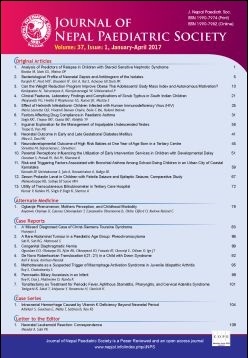Risk and Triggering Factors Associated with Bronchial Asthma Among School-Going Children in an Urban City of Coastal Karnataka
DOI:
https://doi.org/10.3126/jnps.v37i1.16634Keywords:
allergens, asthma, questionnaire, risk factors, smokeAbstract
Introduction: Asthma is common in childhood and is a major public health issue. The objectives of this study were to identify risk and triggering factors associated with asthma among school children.
Material and Methods: A prospective cross sectional study was conducted among 6-15 years old children, over two months in two private schools at Mangalore city. Trigger factors were assessed as per asthma trigger inventory (ATI). Responses were graded from 0-5 score based on ‘never’,’ rarely’, ‘sometimes’, ‘most of the time’ and ‘always’. A predesigned questionnaire suiting the city environment was prepared and used to assess the risk and triggering factors. Analysis was done using SPSS version 16.
Results: Asthma and allergic rhinitis in parents (34.1%,40.7%), smoking at home(24.2%), exclusive breast feeding absence (27.5%),early weaning(24.2%), living in a flat (37.4%) and pets at home(37.4%) were risk factors noted. As per ATI, it was found that ‘having a cold’ was the most frequently selected trigger at 94.5% (47.3% ‘sometimes’, 2.2% ‘always’), followed by ‘running’ at 79.1% (27.5% ‘sometimes’, 13.2% ‘always’), and ‘house dust’ at 69.2% (31.9% ‘sometimes’, 6.6% ‘always’). The highest mean was for infections, (2.228, SD=0.546), followed by physical exercise (2.167, SD=0.331). Animal allergens had lowest mean (1.527, SD=0.104), followed by psychological triggers at second lowest (1.579, SD=0.181). However none of the risk and trigger factors had statistical significance with asthma.
Conclusion: Avoiding exposure to probable triggers and identifying risk factors would aid in planning effective strategic measures with better quality of life.
Downloads
Downloads
Published
How to Cite
Issue
Section
License
Authors who publish with this journal agree to the following terms:
Authors retain copyright and grant the journal right of first publication with the work simultaneously licensed under a Creative Commons Attribution License that allows others to share the work with an acknowledgement of the work's authorship and initial publication in this journal.
Authors are able to enter into separate, additional contractual arrangements for the non-exclusive distribution of the journal's published version of the work (e.g., post it to an institutional repository or publish it in a book), with an acknowledgement of its initial publication in this journal.
Authors are permitted and encouraged to post their work online (e.g., in institutional repositories or on their website) prior to and during the submission process, as it can lead to productive exchanges, as well as earlier and greater citation of published work (See The Effect of Open Access).



